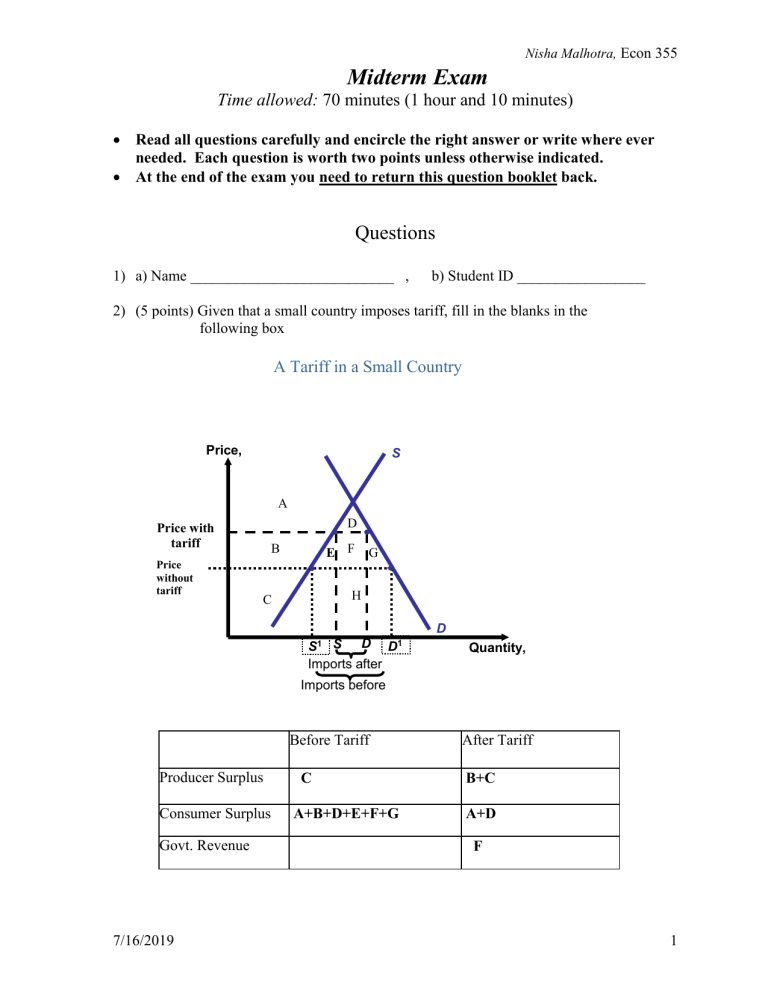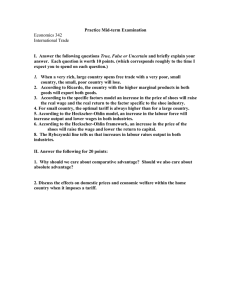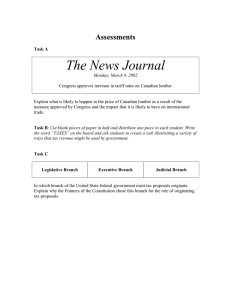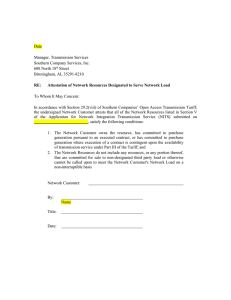
Nisha Malhotra, Econ 355 Midterm Exam Time allowed: 70 minutes (1 hour and 10 minutes) Read all questions carefully and encircle the right answer or write where ever needed. Each question is worth two points unless otherwise indicated. At the end of the exam you need to return this question booklet back. Questions 1) a) Name ___________________________ , b) Student ID _________________ 2) (5 points) Given that a small country imposes tariff, fill in the blanks in the following box A Tariff in a Small Country Price, P S A D Price with tariff Price without tariff B E F G H C D S1 S D D 1 2 2 Imports after tariff before Imports Quantity, Q tariff Before Tariff Producer Surplus Consumer Surplus Govt. Revenue 7/16/2019 C A+B+D+E+F+G After Tariff B+C A+D F 1 Nisha Malhotra, Econ 355 3) In the 2-factor, 2 good Heckscher-Ohlin model, the two countries differ in a. military capabilities. b. size. c. labor productivities. d. relative availabilities of factors of production. e. tastes. Answer: d 4) In the Ricardian Model of trade, under autarky (closed economy) a. Relative prices are determined by technology b. Countries tend to specialize in the production of a single good c. Production is determined by comparative advantage d. None of the above Answer: a 5) The Heckscher-Ohlin model differs from the Ricardian model of Comparative Advantage in that the former a. has only two countries. b. has only two products. c. has two factors of production. d. has two production possibility frontiers (one for each country). e. None of the above. Answer: c 6) The Ricardian model is based on all of the following except a. only two nations and two products. b. product quality varies among nations. c. labor is the only factor of production. d. no diminishing returns. e. None of the above Answer: b 7) The Heckscher-Ohlin model differs from the Ricardian model of Comparative Advantage in that the former a. has only two countries. b. has only two products. c. has two production possibility frontiers (one for each country). d. has two factors of production. e. None of the above 7/16/2019 2 Nisha Malhotra, Econ 355 Answer: d 8) IF the production function for manufactures is given by : QM = QM (K, LM) , and has the following shape. a) b) c) d) The marginal Productivity of labor decreases as labor input increases. The marginal Productivity of labor increases as labor input increase. The marginal Productivity of labor decreases as labor input decreases. The Output decreases as labor unit increases. Answer: a 9) Referring to the information in Table 3, if good S is capital intensive, then following the Heckscher-Ohlin Theory, a. country A will export good S. b. country B will export good S. c. both countries will export good S. d. trade will not occur between these two countries. e. Insufficient information is given. Answer: b Please look at the table very carefully before answering your question! TABLE 3 Assume that only two countries, A and B, exist. The two countries are large enough to influence world prices. Consider the following data: Countries Factor Endowments Capital Stock Labor Force A 20 60 B 10 20 10) A free trade area among WTO members allows free-trade among members AND (choose from the following choices) a. Each member can have its own trade policy towards non-member countries. b. All members are required to have a common external trade policy towards nonmember countries. c. Each member can have its own trade policy towards non-member countries and there is free factor movements (especially labor) among members 7/16/2019 3 Nisha Malhotra, Econ 355 Answer: a Q 11 and Q 12 refer to the following information: FIGURE 1 Suppose you have the following diagram for a country under the 2 factor Heckscher-Ohlin framework, where C stands for cloths and F refers to food production. From Goods Prices to Input Choices Wage-rental ratio, w/r CC FF SS Relative price of cloth, PC/PF 11) Landlabor Ratio, T/L Given the information in Figure 1, how does a decrease in the relative price of cloth affect the use of land and labor in the respective sectors? A. B. C. D. E. Cloth sector increases the use of both land and labor. Food sector increases the use of both land and labor. Cloth sector increases the use of land and decreases the use of labor. Food sector decreases the use of land and increases the use of labor. None of the above. Answer: b Essay Question 12) (10 points) Show using a box diagram what happens when the amount of labor increases in this small economy which takes the world prices as given. Make sure that you answer the following: 1. what happens to Production of cloth and food? 2. what happens to the land and labor ratio in the two sectors (food and cloth) and why ? 3. what happens to wage and rental ratio and why? 4. what happens to relative price of cloth , does it increase or decrease? 7/16/2019 4 Nisha Malhotra, Econ 355 Answer to question 12: You have to label all the graphs. (I am just saving time by not labeling) 1. O2 O2’ Land O1 A B Labor 7/16/2019 5 Nisha Malhotra, Econ 355 The box expands on the side of labor and A is the original equilibrium and B is the new equilibrium . 2. Since it is in a small open economy, the relative price of cloth to food is determined by the world price. So that the ratio of wage to rental price is unchanged and the ratio of land -labor in both sector are unchanged. (you can refer to the figure in question 11). But the production of cloth increases , while the production of food decrease since cloth is labor-intensive sector. 13) We can categorize the US – Canada softwood lumber dispute into 4 categories, Lumber 1, lumber II, Lumber III and Lumber IV. Which dispute saw the first antidumping case filed by the US on the Canadian producers? a. Lumber I b. Lumber II c. Lumber III d. Lumber IV e. All of the above f. None of the above they were all countervailing duty cases. Answer: d 14) How many provinces had restricted imports under the “Softwood Lumber agreement” signed between the US and Canada in April 1996? _________________4________ 15). The principle benefit of tariff protection goes to a. domestic consumers of the good produced. b. foreign consumers of the good produced. c. domestic producers of the good produced. d. foreign producers of the good produced. e. None of the above. Answer: c 16). Who earns the rents if instead of import tariff domestic country imposes import quotas that are auctioned in a fair manner to the domestic firms? (rents=tariff revenue) a. Domestic firms b. Domestic government c. Foreign firms d. Foreign government e. Domestic firms Answer: b 7/16/2019 6 Nisha Malhotra, Econ 355 17). What is true in case of a small country (small such that it can not influence world prices)? a. The optimum tariff is zero b. The optimum tariff is positive but beyond a point increase in tariff reduces total welfare c. The optimum tariff is based on the following graph Answer: a Essay Question 18) (10 points) WTO allows “protection to domestic industry” in specific cases by means of trade remedy measures. a) What are these trade remedy measures? b) For each trade remedy measure explain under what circumstances can these be used by a country. (Not to exceed 30 words) Answer: a) (3 marks) Antidumping; Countervailing duty; Safeguard measures. b) 1) (3 marks) Antidumping: Dumping by foreign firms; Injury to domestic industry; country shows that there is relationship b/w dumping and injury. 2) (3 marks) Countervailing duty: Export subsidy by foreign government; Injury to domestic industry; country shows that there is relationship b/w countervailing duty and injury. 3) (2 marks) Safeguard measure: against nothing; domestic industry is dying or injured. 7/16/2019 7



